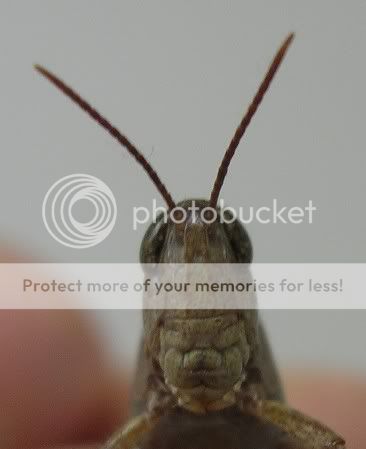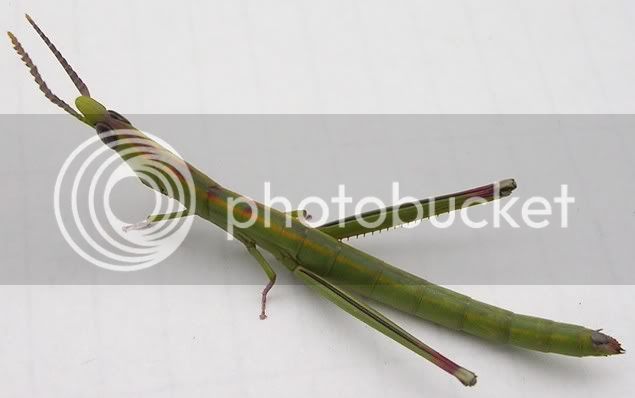A lot of people have been asking about the Warramaba and a couple of
people have asked me how the Warramaba 'hoppers faces
compare to a regular grasshopper's face, so last night I took a photo of
my pet grasshopper for the comparrison. She is one I caught just
outside the animal house I work in. I'm not sure what species it is, but
it's one of the most beautiful of the Melbourne grasshoppers, although
the face is the same as any old standard species. The Warramamba are
members of a very specialised group of grasshoppers, the Morabines. I
did take a few pictures of non Warramaba Morabines, but they didn't turn
out too well, so just imagine something with a face the shape of a
Warramaba and the plain brown colour of a normal grasshopper.
I also threw in a picture showing the dorsal side of a Warramaba "P196"
They come in a massive variety of colours, including every shade of
green, purple, black, red, orange and yellow and rarely grey or brown
(the grey/brown ones get us very excited for genetic reasons, as well as
the fact that they're very rare). The one shown is fairly similar to some of
the clones you find in the eastern states, even though it's a different (non
parthenogenetic) species from WA.
Here's what most grasshopper faces look like (sometimes green, although
even many of the green ones have brown faces, this one is green
dorsally).

Here's another Warramaba.

and the dorsal shot

enjoy.
people have asked me how the Warramaba 'hoppers faces
compare to a regular grasshopper's face, so last night I took a photo of
my pet grasshopper for the comparrison. She is one I caught just
outside the animal house I work in. I'm not sure what species it is, but
it's one of the most beautiful of the Melbourne grasshoppers, although
the face is the same as any old standard species. The Warramamba are
members of a very specialised group of grasshoppers, the Morabines. I
did take a few pictures of non Warramaba Morabines, but they didn't turn
out too well, so just imagine something with a face the shape of a
Warramaba and the plain brown colour of a normal grasshopper.
I also threw in a picture showing the dorsal side of a Warramaba "P196"
They come in a massive variety of colours, including every shade of
green, purple, black, red, orange and yellow and rarely grey or brown
(the grey/brown ones get us very excited for genetic reasons, as well as
the fact that they're very rare). The one shown is fairly similar to some of
the clones you find in the eastern states, even though it's a different (non
parthenogenetic) species from WA.
Here's what most grasshopper faces look like (sometimes green, although
even many of the green ones have brown faces, this one is green
dorsally).

Here's another Warramaba.

and the dorsal shot

enjoy.




